Old-Fashioned Crabapple Butter Recipe (Perfect for Canning or Freezing)
Turn tart crabapples into a rich, spiced butter that tastes like fall in a jar. This easy, old-fashioned recipe walks you through every step.
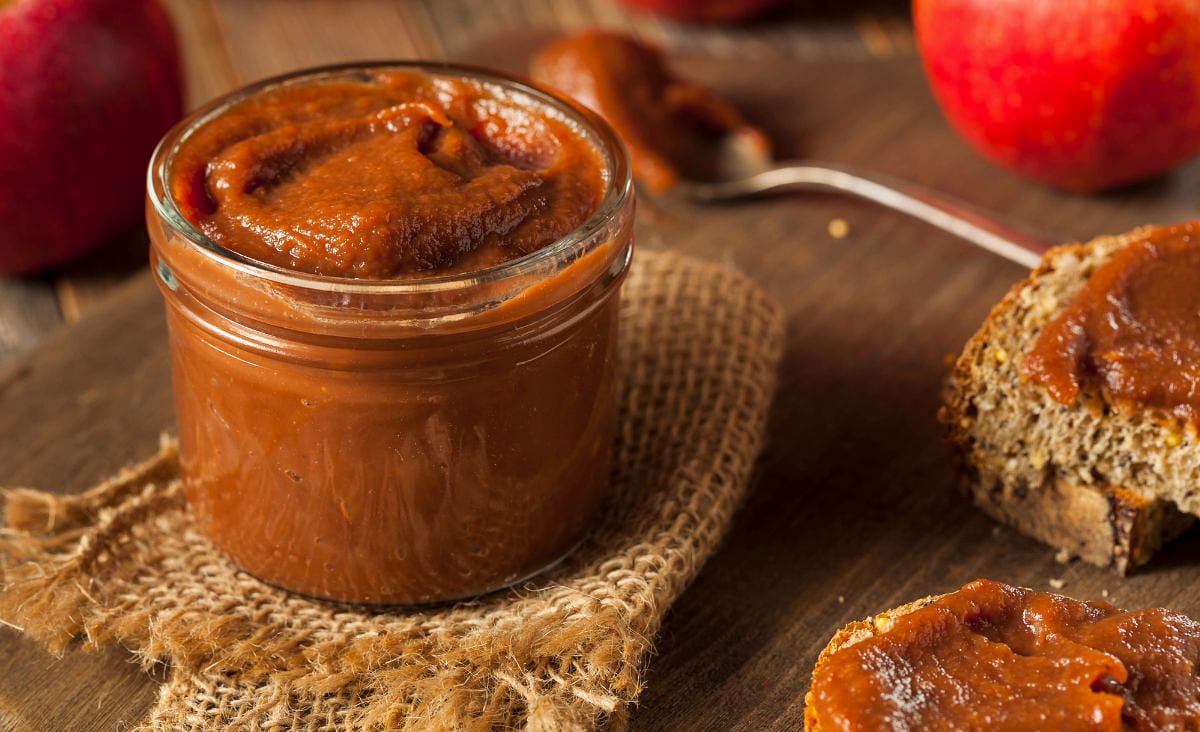
Every fall, I catch myself staring at the crabapple trees wondering what on earth I’m supposed to do with all these tiny, tart apples. They’re not great for snacking, they make your mouth pucker if you try to eat one raw, and yet… they’re far too good to waste.
That’s where this crabapple butter recipe comes in. It turns those little sour apples into something yummy, with just the right hint of spice. It’s perfect on toast, stirred into oatmeal, or gifted in little jars come holiday season. It’s one of those old-fashioned recipes that just tastes like fall.
I’ll show you how I make crabapple butter (on the stove or in the slow cooker), how to can it safely, and a few simple ways ‘spice up’ the flavor. I’ll also answer a few common questions I get from readers about substitutions, storage, and whether or not you really have to peel all those crabapples. (Spoiler: you don’t.)
Why Crabapples Make the Best Fruit Butter
Crabapples don’t get nearly enough credit. Honestly, I think they make the best apple butter out there. Their natural tartness balances perfectly with sugar and spice, giving you that mix of tart and sweet that regular apples can’t quite pull off. Plus, their high pectin content means the butter thickens beautifully on its own, no added thickeners needed.
Crabapples are ready to harvest in late summer through early fall, which makes this a perfect transitional recipe between jam season and the start of full-blown canning chaos. If you’re lucky enough to have a tree, you’ll know that a single afternoon’s picking can yield more fruit than you’d think possible. This recipe is one of the easiest (and tastiest) ways I know to put that harvest to good use.
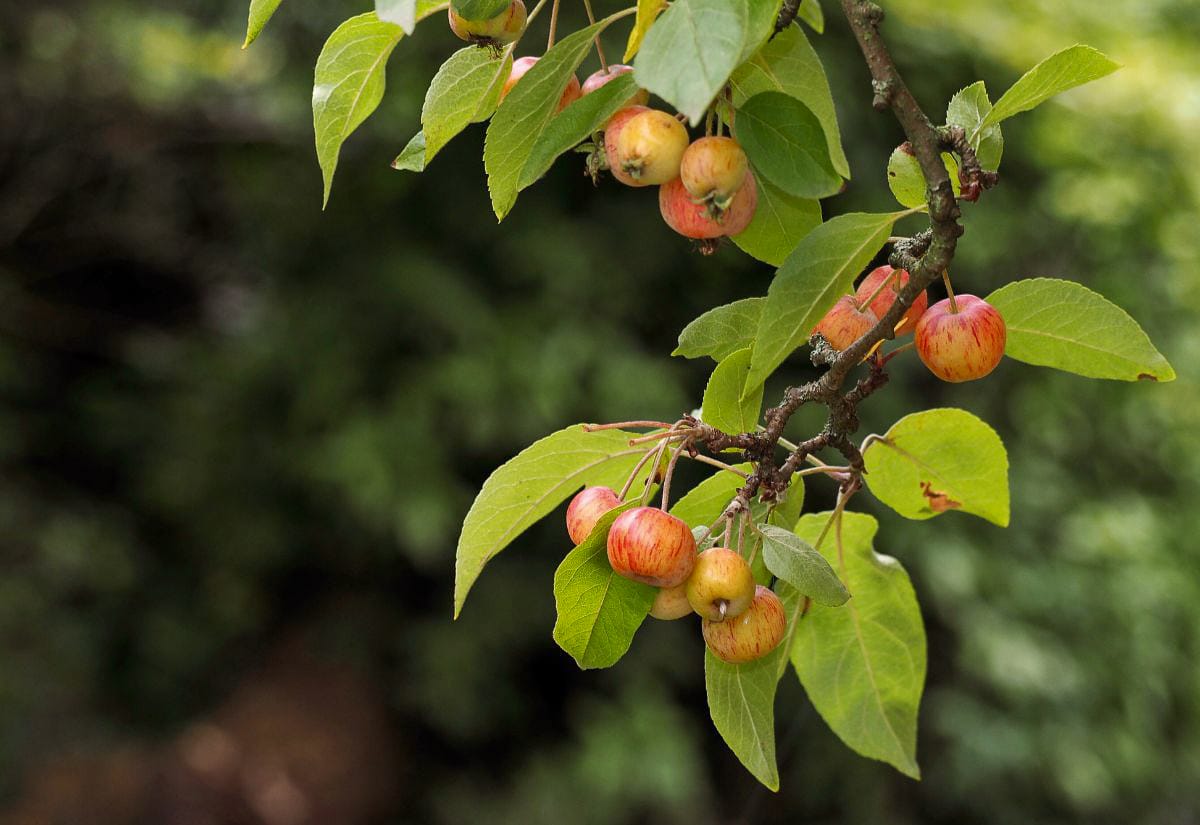
When I made my first batch years ago, I used a mix of wild crabapples and a few windfall Cortlands, mostly because that’s what I had lying around. The flavor turned out incredible! Tangy with just enough sweetness to make you go back for another spoonful.
If you’re swimming in apples this season, you might also like my guide on how to dehydrate apples without browning, which walks you through simple methods to preserve those slices for snacks, baking, or long-term storage.
Ingredients You’ll Need
You only need a few pantry staples and a slow cooker. It’s the kind of recipe that makes the whole house smell like fall. Every time I make it, the kids start hovering.
You’ll need:
- Fresh crabapples
- Water
- Sugar
- Lemon juice
- Ground cinnamon (plus optional cloves or allspice if you like extra warmth)
That’s it. You can also add a splash of vanilla or a drizzle of maple syrup for a softer, sweeter twist.
How to Make Crabapple Butter
Here’s how to turn those little tart apples into the best butter you’ve ever tasted.
Cook the Crabapples
Give your crabapples a good wash and remove any stems or bad spots. You don’t need to peel or core them. Just cut them in half or quarters and toss them in a large pot with enough water to barely cover.
Bring them to a boil, then simmer about half an hour, until they’re soft enough to mash easily with the back of a spoon.
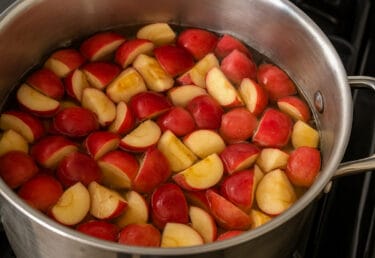
Make the Pulp
Run the cooked apples through a food mill or fine sieve to separate skins and seeds from the pulp. You can also use an immersion blender if you’ve already removed the seeds. Whatever gets you a nice, smooth puree. Don’t overthink it.
Don’t toss the skins… they’re gold! I save mine to start a batch of homemade apple cider vinegar, but they’re fine to compost too.
Cook It Down
Return the pulp to your pot or a slow cooker. Add sugar (start with about half the volume of your pulp), lemon juice, and spices. If your crabapples are extra tart, just stir in a little more sugar until it tastes right. Stir well.
Let it cook uncovered on low for 8–10 hours in the slow cooker (or on the stove over low heat), stirring now and then until it’s thick, dark, and spreadable. You’ll know it’s ready when a spoonful sits up on the plate instead of running. Nice and thick.
How to Can Crabapple Butter
Canning means you can enjoy it all winter (or hand out jars as gifts) without filling up your fridge.
- Sterilize jars by simmering them in boiling water for 10 minutes.
- Ladle hot butter into jars, leaving ¼ inch of headspace.
- Wipe rims clean and secure lids and bands.
- Process in a boiling water bath for 10 minutes (adjust for altitude if needed).
- Cool undisturbed for 12–24 hours. Check seals. Lids should be concave and not move when pressed.
Stored in a cool, dark spot, canned crabapple butter will keep for up to a year. I’ve opened jars ten months later and they still taste like the day I made them. Totally worth the bit of effort up front.
If you’d rather skip canning, refrigerate it for up to 3 weeks or freeze it for up to 6 months. Just make sure to leave a little space at the top of the jar for expansion.
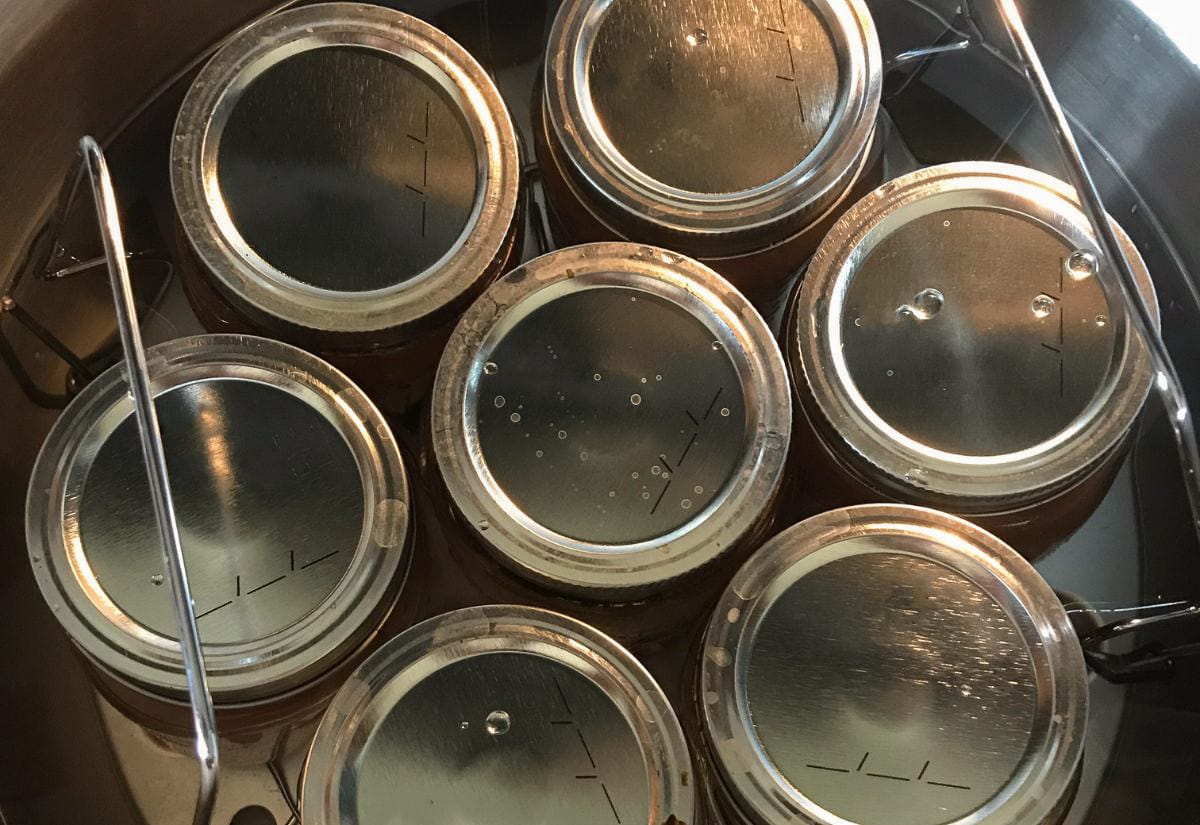
Flavor Variations to Try
Once you’ve made a batch or two, you’ll start thinking of all kinds of ways to change it up.
- Cinnamon-Maple: Add 2 tablespoons of real maple syrup at the end of cooking for a cozy twist.
- Vanilla Bean: Split a vanilla bean and let it simmer with the butter.
- Bourbon-Spice: Stir in a tablespoon of bourbon and a pinch of nutmeg for something a little special.
I’ve also swapped in a few regular apples when I didn’t have enough crabapples. It’s surprisingly forgiving. Hard to mess up, really.
If you enjoy blending sweet and savory flavors, you’ll love my Roast Chicken with Sweet Potato, Apple & Cranberry Stuffing.
How to Use Crabapple Butter
This isn’t just a toast spread, though that’s certainly my favorite way to eat it.
It’s delicious swirled into oatmeal or spooned over yogurt, and it makes an incredible filling for thumbprint cookies or layered cakes. I’ve also used it as a glaze for pork chops and roasted sweet potatoes. That tangy-sweet balance tastes amazing with savory dishes. And if you’re the gifting type, a few small jars tied with twine and a sprig of cinnamon make the kind of homemade gift people actually use (and usually ask me to make again next year).
For another cozy fall treat, try my Quick and Easy Gluten-Free Apple Crumble.
Before You Start Canning, Read This
Still have a few questions? You’re not alone. Here are the ones that come up most often.
Love cozy fall recipes? Save this crabapple butter recipe for when your trees are loaded with fruit.
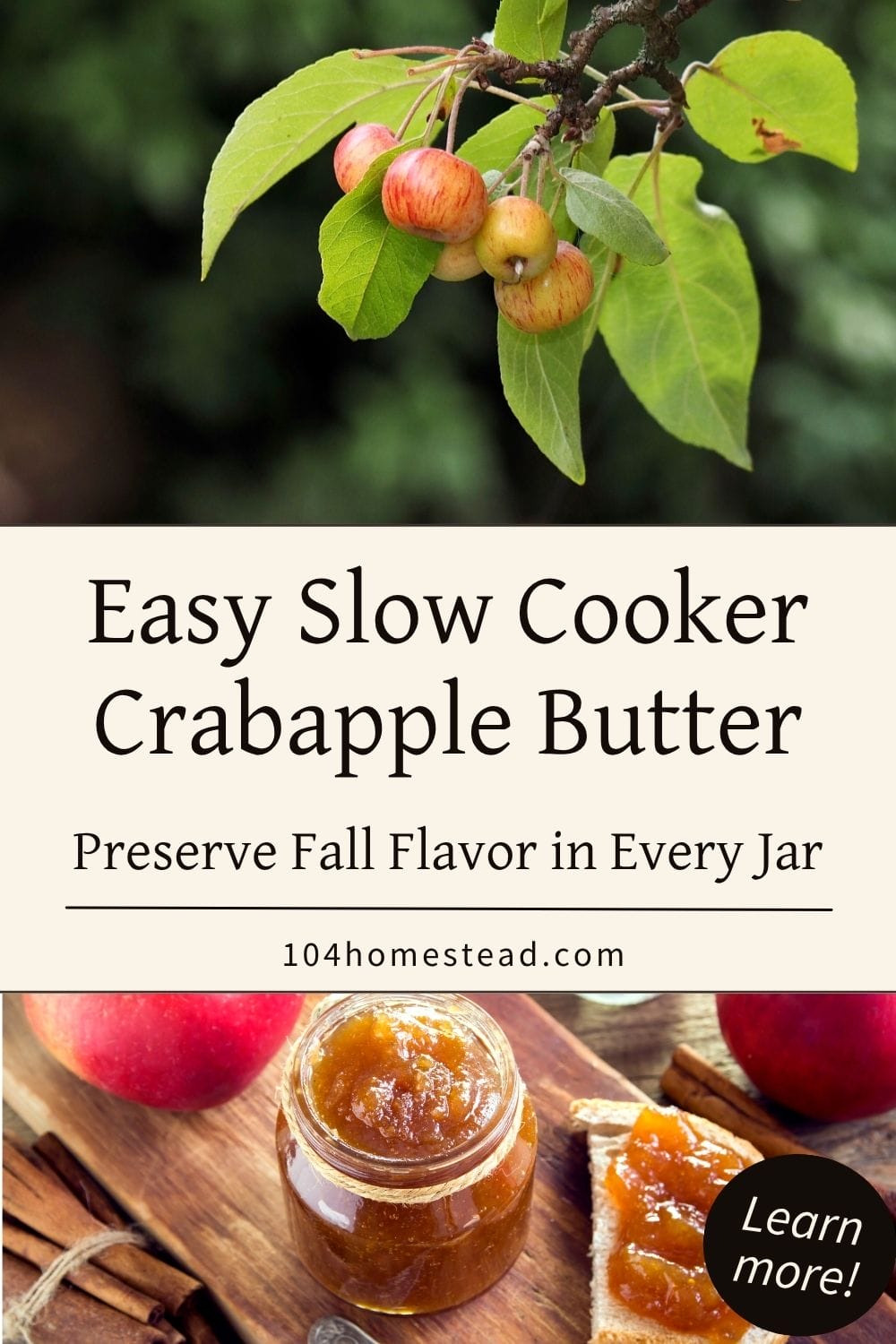
If you’ve got a yard full of crabapples, making butter is one of the best ways to honor that harvest. It’s simple, satisfying, and tastes exactly like fall in a jar. Whether you can it, freeze it, or just eat it by the spoonful straight from the jar (no judgment here), it’s one of those old-school homestead recipes that never lets me down.
So grab a basket and get picking! Your kitchen’s about to smell amazing.
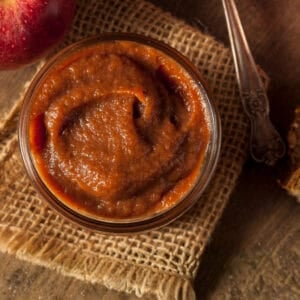
Old-Fashioned Crabapple Butter
This post may contain paid links. If you make a purchase using the links in this recipe, I may earn a commission.
Equipment
- 1 Large Pot
- 1 Food Mill or fine mesh strainer/immersion blender
- 1 Water Bath Canner optional, for preserving
Ingredients
- 6.5 lbs. Crabapples
- 5 c. Sugar
- 2 med. Oranges zest and juice
- 1 tsp. Ground Cinnamon
- ⅜ tsp. Ground Nutmeg
- ⅜ tsp. Ground Allspice
Instructions
- Wash crabapples well and remove stems or bad spots. No need to peel. Cut into halves or quarters and place in a large pot with 1 cup of water.6.5 lbs. Crabapples
- Bring to a boil, then reduce to a simmer for about 30 minutes, or until soft and falling apart.
- Let cool slightly, then run through a food mill or use an immersion blender to create a smooth pulp.
- Combine the crabapple pulp, sugar, orange zest and juice, and spices in a slow cooker or heavy-bottomed pot.5 c. Sugar, 2 med. Oranges, 1 tsp. Ground Cinnamon, 3/8 tsp. Ground Nutmeg, 3/8 tsp. Ground Allspice
- Cook uncovered on low for 8–10 hours, stirring now and then, until the mixture is thick, dark, and spreadable. You’ll know it’s ready when a spoonful sits up on the plate instead of running.
- Ladle into clean jars or containers while hot. If canning, see Notes below for detailed processing steps. Otherwise, let cool and refrigerate for up to 3 weeks or freeze for up to 6 months.
Notes
- Sterilize jars, lids, and bands by simmering in boiling water for 10 minutes.
- Fill hot jars with butter, leaving ¼ inch headspace.
- Wipe rims, add lids, and secure bands.
- Process in a boiling water bath for 10 minutes (adjust for altitude if needed).
- Cool 12–24 hours, then check seals. Store sealed jars in a cool, dark place for up to a year.

In your description below the title you say without peeling or coring, then in instructions 2 and 3 you peel and core. I have a crabapple tree that has very nice apples for fresh eating and jelly but they are too small to core and peel. I don’t have a food mill but I am considering getting one so I can make sauce and butter without the fiddlyness of peeling or coring. But because I am unfamiliar with how a food mill works I’m hoping to get some clarification
I see that’s showing in the recipe card and I’m honestly sure where that came from. That’s suppose to be the recipe summary, so I’m not sure what happened there. I’m so sorry for that confusing information and I am going to investigate what happened.
How many 8oz jars does this recipe make? Thanks!
How do I get the bitter taste out of my crabapple butter. I followed your recipe. Maybe I picked them too soon.
Did you cut the blossoms and stem from the crab before you cooked them? APPARENTLY THEY MAKE THE SAUCE BITTER. HOPE THIS HE LPS.
Looks delicious! I never would have thought of using crab apples like this. 🙂
What is the easiest way to make crab apple pulp?
Unless you have a fancy pulp machine and/or juicer, you can simply chop the apple into small chunks. They will break down as they cook.
If not using a pulp machine, I’m guessing we will strain the mixture after cooking in crockpot. Correct?
If you don’t have a pulp machine, you can peel, cut, and core the apples and mash them with a potato masher as they soften in the slow cooker. I’m afraid straining would turn it into a loose jelly instead of a fruit butter. You can also run it through a Cuisinart or blender after it’s softened.
Thank you so much for the recipe for crabapple butter. I have been playing with crabapples for 4 or 5 years now and everyone thinks I am crazy. When you say pulp that is your “precooked” apples correct? I am in the process right now of making some crabapple cinnamon jelly and was thinking since you only use juice for jelly I could use the leftovers for butter?
Great question Bridget! I think it might work, but here are my thoughts. First, I’d cut back the amount of sugar a bit since there will be less fluid in the mix and you don’t want it too thick with the full amount of sugar. Second, you may want to play around with the amount of spices you add. I don’t know how much change to the flavor there would be with less juice.
Be sure to report back with how it goes. 2-for-1 would be awesome!
what quantity of crab apples did you use to make the pulp please ?as I have several pounds off my tree this year
It took about 4 pounds of apples to get my 12 cups of pulp.
This sounds delicious, Jess! I really must find someone with a crab apple tree!
I shared this post on My Week on Wednesday. 🙂
~ Christine
In the crockpot as I type! Preliminary tasting is exquisite! Thank you for giving me something great to make with my millions of crabapples. I finally feel like they’re not going to waste. 🙂
And it’s really so easy. Let me know what you think when you try it.
oh wow! This sounds sooooo good! Thanks, I have to try that 🙂